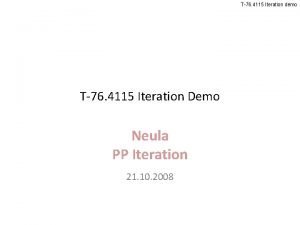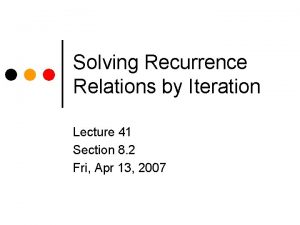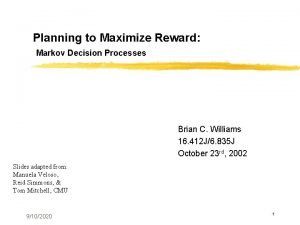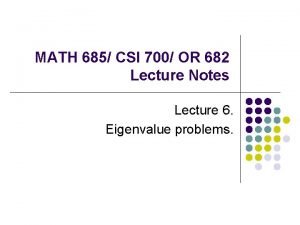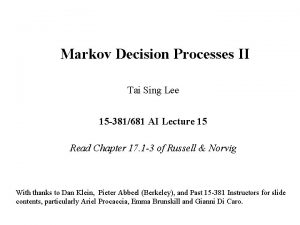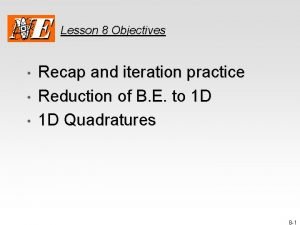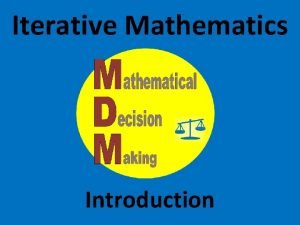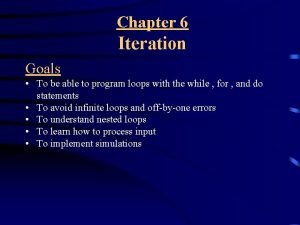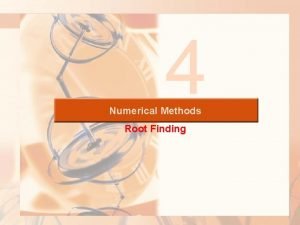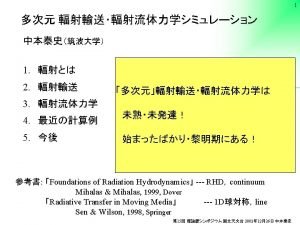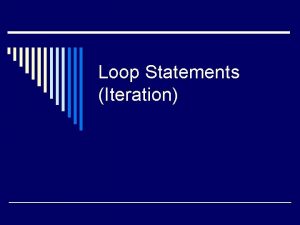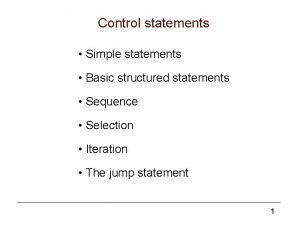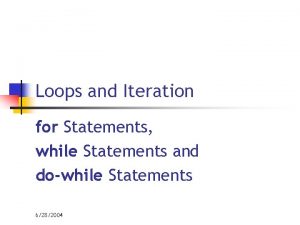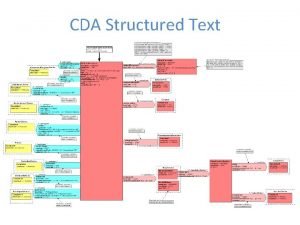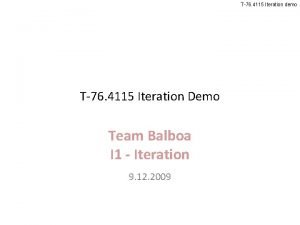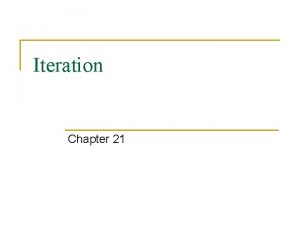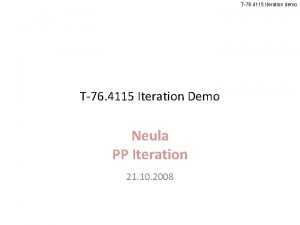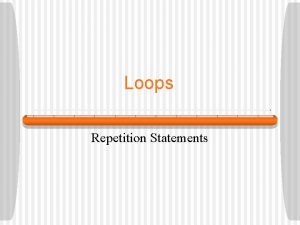Writing Structured Programs Ernastuti Four iteration statements 1

























![Insertion Sort Insertion-Sort(A) 1 for j 2 to length[A] 2 do key A[j] 3 Insertion Sort Insertion-Sort(A) 1 for j 2 to length[A] 2 do key A[j] 3](https://slidetodoc.com/presentation_image_h2/6264d249879031cc3fe04b1dad00c18d/image-26.jpg)

- Slides: 27

Writing Structured Programs Ernastuti

Four iteration statements 1. 2. 3. 4. loop-repeat while-repeat loop-until-repeat for-repeat

Loop-repeat S loop read(x) if x = eof then exit endif call PROCESS(x) repeat

While-repeat true cond false while cond do S repeat S

loop-until-repeat false S cond true loop S until cond repeat

For-repeat false S cond true for vble start to finish by increment do S repeat

for-repeat true S cond vble start false finish increment while ( vble – fin ) * incr 0 do S vble + incr for vble start to finish by increment do repeat S repeat

The case for CASE if cond 1 then S 1 else if cond 2 then S 2 else if cond 3 then S 3. . else if cond n then Sn else Sn+1 endif …endif case : cond 1 : S 1 : cond 2 : S 2 : cond n : Sn : else : Sn+1 endcase

Find the maximum of n numbers, n > 0 procedure MAX(A, n, j) // Set j so that A(j) is the maximum in A(1: n), n>0 // xmax A(1); j 1 for i 2 to n do If A(i) >xmax then xmax A(i); j i ; endif repeat end MAX

Find the maximum of n numbers, n > 0 procedure MAX 1(i) //this is a function which returns the largest integer k such that A(k) is the maximum element in A(i: n)// global integer n, A(1: n), j, k ; integer i if i < n then j MAX 1(i+1) if A(i) >A(j) then k i else k j endif else k n endif return(k) end MAX 1

procedure MAX 2(i) local integer j, k; global integer n, A(1: n); integer i integer STACK(1: 2*n); top 0 L 1: if i < n then top + 1; STACK(top) i top + 1; STACK(top) 2; i i+1 go to L 1 L 2: j STACK(top); top – 1 if A(i) >A(j) then k i else k j endif else k n endif If top=0 then return(k) else addr STACK(top); top – 1 i STACK(top); top – 1 top + 1; STACK(top) k If addr = 2 then go to L 2 endif end MAX 2

procedure MAX 3(A, n) integer i, k, n; i k-n while i>1 do i i-1 if A(i) >A(k) then k i endif repeat return(k) end MAX 3

Read a set of values until their sum exceeds a predefined limit, say n y 0 while y n do read(x) y y+x repeat

Read in n values and process each one in some way i 1 while i n do read(x) call PROCESS(x) i i+1 repeat for i 1 to n do read(x) call PROCESS(x) repeat

Recursion The fibonacci sequence 1, 1, 2, 3, 5, 8, 13, 21, 34, … is defined as F 0 = F 1 = 1, Fi = Fi-1 + Fi-2 , i>1 procedure F(n) //returns the nth Fibonacci number// Integer n If n 1 then return(1) else return(F(n-1) + F(n-2)) endif end F

procedure F 1(n) // a function which returns the nth Fibonacci number// If n < 2 then return(1) else return(F 2(2, n, 1, 1)) endif end F 1 procedure F 2(i, n, x, y) If i n then call F 2(i+1, n, y, x+y) endif return(y) end F 2

Computing the greatest common divisor of two nonnegative integers For example : gcd(22, 8)= ? 22 = 1 x 2 x 11 8 = 1 x 23 gcd(22, 8) = 2 Another way : gcd(22, 8)=gcd(8, 6)=gcd(6, 2)=gcd(2, 0)=2

Computing the greatest common divisor of two nonnegative integers For example : gcd(21, 13)= ? 21 = 1 x 3 x 7 13 = 1 x 13 gcd(21, 13) = 1 Another way : gcd(21, 13)=gcd(13, 8)=gcd(8, 5)=gcd(5, 3)= gcd(3, 2)=gcd(2, 1)=gcd(1, 0)=1

Computing the greatest common divisor of two nonnegative integers procedure GCD(a, b) // assume a > b 0 // if b = 0 then return(a) else return(GCD(b, a mod b)) endif end GCD

Computing the greatest common divisor of two nonnegative integers procedure GCD 1(a, b) L 1: if b=0 then return(a) else t b; b a mod b; a t; go to L 1 endif end GCD 1

Computing the greatest common divisor of two nonnegative integers procedure GCD 2(a, b) while b 0 do t b; b a mod b; a t repeat return(a) end GCD 2

A procedure which searches for x in A(1: n) procedure SEARCH(i) //if there exists an index k such that A(k) = x in A(i: n), then the first such k is returned else zero is returned// global n, x, A(1: n) case : i> n : return(0) : A(i) = x : return(i) : else : return(SEARCH(i+1)) endcase end SEARCH

Analyzing Algoriths x x+y 1 for i 1 to n do x x+y repeat n 2

Orders of magnitude • The order of magnitude of a statement refers to its frequency of execution while • The order of magnitude of an algorithm refers to the sum of the frequencies of all of its statements

• Determining the order of magnitude of an algorithm is very important and producing an algorithm which is faster by an order of magnitude is a significant accomplishment. • The a priori analysis of algorithms is concerned chiefly with order of magnitude determination • Fortunately there is a convinient mathematical notation for dealing with this concept. • A priori = berdasarkan teori drpd kenyataan yg sebenarnya
![Insertion Sort InsertionSortA 1 for j 2 to lengthA 2 do key Aj 3 Insertion Sort Insertion-Sort(A) 1 for j 2 to length[A] 2 do key A[j] 3](https://slidetodoc.com/presentation_image_h2/6264d249879031cc3fe04b1dad00c18d/image-26.jpg)
Insertion Sort Insertion-Sort(A) 1 for j 2 to length[A] 2 do key A[j] 3 Insert A[j] into the sorted sequence A[1. . j-1] 4 i j -1 5 while i >0 and A[i]>key do A[i+1] A[i] 6 7 i i -1 8 A[i+1] key cost c 1 c 2 times n n-1 0 c 4 c 5 c 6 c 7 c 8 n-1 tj (tj – 1) n-1

• The running time of the algorithm is the sum of running time for each statement executed; • To compute (n), the running time of Insertion-Sort, we sum the products of the cost and times columns, obtaining (n) = c 1 n + c 2(n-1) + c 4(n-1)+ c 5 tj + c 6 (tj – 1) + c 7 (tj – 1) + c 8(n-1)
 Iteration statements in java
Iteration statements in java Unstructured interview
Unstructured interview What is sa/sd methodology?
What is sa/sd methodology? Disadvantages of waterfall model in software engineering
Disadvantages of waterfall model in software engineering Four financial statements
Four financial statements Four primary financial statements
Four primary financial statements Persuasive wrting
Persuasive wrting What is pes statement
What is pes statement Shape with four straight sides
Shape with four straight sides Skin assessment charting
Skin assessment charting Condition for convergence of newton raphson method
Condition for convergence of newton raphson method Iteration demo
Iteration demo Solving recurrence relations by iteration
Solving recurrence relations by iteration Iterative vs recursive
Iterative vs recursive Sequence, selection, iteration
Sequence, selection, iteration Value iteration
Value iteration Value iteration
Value iteration Orthogonal iteration
Orthogonal iteration Value iteration algorithm
Value iteration algorithm Markov decision process
Markov decision process What is the purpose of an iteration recap
What is the purpose of an iteration recap Iterative rule for sequence
Iterative rule for sequence What is iteration in computer science
What is iteration in computer science Recursion
Recursion Iteration definition computer science
Iteration definition computer science Iteration goals
Iteration goals Birge-vieta method uses formula of which method
Birge-vieta method uses formula of which method Lambda iteration
Lambda iteration











